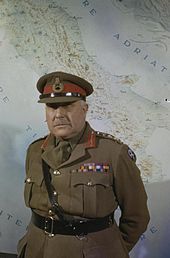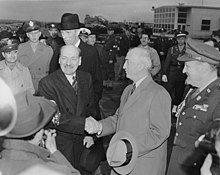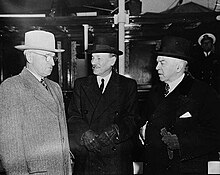British contribution to the Manhattan Project
Following the discovery of nuclear fission in uranium, scientists Rudolf Peierls and Otto Frisch at the University of Birmingham calculated, in March 1940, that the critical mass of a metallic sphere of pure uranium-235 was as little as 1 to 10 kilograms (2.2 to 22.0 lb), and would explode with the power of thousands of tons of dynamite.
Mark Oliphant, an Australian physicist working in Britain, was instrumental in making the results of the British MAUD Report known in the United States in 1941 by a visit in person.
Oliphant had delegated the task to two German refugee scientists, Rudolf Peierls and Otto Frisch, who could not work on the university's radar project because they were enemy aliens and therefore lacked the necessary security clearance.
Sir John Anderson, the Lord President of the Council, became the minister responsible, and Wallace Akers from Imperial Chemical Industries (ICI) was appointed the director of Tube Alloys.
[13] In July 1940, Britain had offered to give the United States access to its scientific research,[14] and the Tizard Mission's John Cockcroft briefed American scientists on British developments.
Oliphant, one of the Maud Committee's members, flew to the United States in late August 1941, and discovered that vital information had not reached key American physicists.
[15][16] Armed with British data, Vannevar Bush, the director of the Office of Scientific Research and Development (OSRD), briefed Roosevelt and Vice President Henry A. Wallace in a meeting at the White House on 9 October 1941.
[18] In November 1941, Frederick L. Hovde, the head of the London liaison office of OSRD, raised the issue of cooperation and exchange of information with Anderson and Lord Cherwell, who demurred, ostensibly over concerns about American security.
[21] On 30 July 1942, Anderson advised the Prime Minister of the United Kingdom, Winston Churchill, that: "We must face the fact that ... [our] pioneering work ... is a dwindling asset and that, unless we capitalise it quickly, we shall be outstripped.
A gaseous diffusion plant to produce 1 kilogram (2.2 lb) of weapons-grade uranium per day was estimated to cost up to £3,000,000 in research and development, and anything up to £50,000,000 to build in wartime Britain.
In particular, the Manhattan Project could benefit enough from assistance from James Chadwick, the discoverer of the neutron, and several other British scientists to warrant the risk of revealing weapon design secrets.
None of them was aware that Roosevelt had already made his decision,[31] writing to Bush on 20 July 1943 with instructions to "renew, in an inclusive manner, the full exchange with the British Government regarding Tube Alloys.
Dill died in Washington, D.C., in November 1944 and was replaced both as Chief of the British Joint Staff Mission and as a member of the Combined Policy Committee by Field Marshal Sir Henry Maitland Wilson.
[38] Even before the Quebec Agreement was signed, Akers had already cabled London with instructions that Chadwick, Peierls, Oliphant and Francis Simon should leave immediately for North America.
The Combined Policy Committee ratified the proposals in December 1943, by which time several British scientists had already commenced working on the Manhattan Project in the United States.
At that time, the United States controlled, by a supply contract, the only major production site on the continent, that of the Consolidated Mining and Smelting Company at Trail, British Columbia.
[56] Gaseous diffusion technology was devised by Simon and three expatriates, Nicholas Kurti from Hungary, Heinrich Kuhn from Germany, and Henry Arms from the United States, at the Clarendon Laboratory in 1940.
[58] The Quebec Agreement allowed Simon and Peierls to meet with representatives of Kellex, who were designing and building the American gaseous diffusion plant, Union Carbide and Carbon, who would operate it, and Harold Urey's Substitute Alloy Materials (SAM) Laboratories at Columbia University, the Manhattan Project's centre tasked with research and development of the process.
[61] On 26 May 1943, Oliphant wrote to Appleton to say that he had been considering the problem of electromagnetic isotope separation, and believed that he had devised a better method than Lawrence's, one which would result in a five to tenfold improvement in efficiency, and make it more practical to use the process in Britain.
"[82] Four members of the British Mission became group leaders: Bretscher (Super Experimentation), Frisch (Critical Assemblies and Nuclear Specifications), Peierls (Implosion Hydrodynamics) and George Placzek (Composite Weapon).
[92] He served as a member of the target committee established by Groves to select Japanese cities for atomic bombing,[93] and on Tinian with Project Alberta as a special consultant.
Britain had little need for uranium ores while the war continued, but was anxious to secure adequate supplies for its own nuclear weapons programme when it ended.
[110][111]In December 1943, Groves sent Robert R. Furman to Britain to establish a London Liaison Office for the Manhattan Project to coordinate scientific intelligence with the British government.
[114] At the urging of Groves and Furman, the Alsos Mission was created on 4 April 1944 under the command of Lieutenant Colonel Boris Pash to conduct intelligence in the field relating to the German nuclear energy project.
[118][119] In June 1945, Welsh reported that the German nuclear physicists captured by the Alsos Mission were in danger of being executed by the Americans, for being part of the Nazi military-industrial complex that used and killed concentration camp victims.
"[121] He considered Britain's key contributions to have been encouragement and support at the intergovernmental level, scientific aid, the production of powdered nickel in Wales, and preliminary studies and laboratory work.
On 15 November 1945, Groves, Robert P. Patterson and George L. Harrison met a British delegation consisting of Anderson, Wilson, Malcolm MacDonald, Roger Makins and Denis Rickett to draw up a communiqué.
Truman cabled on 20 April that he did not see the communiqué he had signed as obligating the United States to assist Britain in designing, constructing and operating an atomic energy plant.
[135] In January 1948, Bush, James Fisk, Cockcroft and Mackenzie concluded an agreement known as the modus vivendi, that allowed for limited sharing of technical information between the United States, Britain and Canada.
[137] British wartime participation in the Manhattan Project provided a substantial body of expertise that was crucial to the success of High Explosive Research, the United Kingdom's post-war nuclear weapons programme,[138] although it was not without important gaps, such as in the field of plutonium metallurgy.









